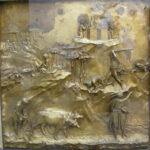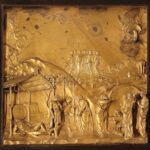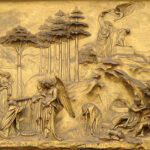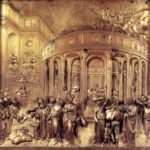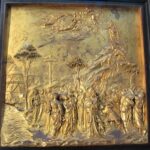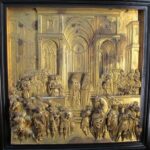Introduction: Ghiberti’s Florentine Treasure
Lorenzo Ghiberti’s Gates of Paradise adorn the Florence Baptistery. They stand as a seminal achievement of Renaissance art. Moreover, these doors represent a defining monument in sculpture’s evolution. These gilded bronze doors offer far more than a mere entryway. In fact, they form a complex narrative masterpiece. People widely celebrate this work for its innovative techniques. These techniques notably include the revolutionary use of perspective and its profound artistic beauty. This article will explore several key aspects. First, it examines the historical context of the Gates of Paradise commission. Second, it delves into Ghiberti’s groundbreaking artistic methods. Finally, the article discusses their lasting influence on subsequent artists. This influence firmly cements their status as an invaluable Florentine treasure.
The Birth of a Renaissance Icon

From a Prestigious Commission to Sublime Artistry
The Arte di Calimala, Florence’s influential cloth merchants’ guild, initiated the journey. They commissioned the work that people would eventually call the Gates of Paradise. This was not Lorenzo Ghiberti’s first major project for the Florence Baptistery. Indeed, his earlier work on the North Doors had already established his reputation as a master sculptor. Consequently, in 1425, the guild decided to commission the East Doors. They turned to Ghiberti once more. This time, there was no formal competition, unlike the North Door commission. This new undertaking offered Ghiberti considerable artistic freedom. Initial concepts might have suggested a traditional layout. This could have been similar to the 28 panels of the North Doors. However, Ghiberti envisioned a more innovative approach. Therefore, he proposed a design featuring ten large, square panels. This format allowed for more expansive and complex narrative scenes. It also provided a grander canvas for his sculptural storytelling. This evolution shows Ghiberti’s maturing vision. It moved from a prestigious, yet potentially conventional, assignment to sublime artistry. This artistry truly defines the Gates of Paradise. Furthermore, it reflects the burgeoning artistic ambition of Renaissance Florence. The city sought not just functional objects. It desired enduring statements of cultural and artistic prowess.
The Meticulous Crafting of the Panels
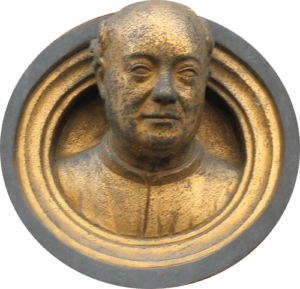
Creating the ten bronze panels for the Gates of Paradise was a monumental task. It spanned an astonishing 27 years, from 1425 to 1452. This lengthy period did not indicate idleness. Instead, it reflected the immense complexity and precision of Ghiberti’s chosen method. He used bronze casting with the lost-wax process. Each panel began as a detailed wax model. Ghiberti sculpted these models with incredible finesse. He then encased each model in layers of clay to create a mold. Once the clay hardened, he melted out the wax (hence “lost-wax”). This left a hollow cavity. Into this cavity, workers poured molten bronze. This process was fraught with potential for error. Consequently, it required immense skill and patience. A single imperfection in the mold could ruin months of work. An issue during pouring could also destroy a panel, costing years of effort. After casting, the panels underwent an extensive finishing process. This laborious stage is known as “chasing.” During this, Ghiberti and his workshop meticulously cleaned the bronze surfaces. They also tooled and polished them. Their goal was to achieve the desired detail and a lustrous finish. This sheer dedication to perfection marked every stage. From initial design to final gilding, it underscores the sublime artistry. This artistry truly defines the Gates of Paradise. It was a labor of love. Or, perhaps more accurately, it was a labor of artistic devotion on an epic scale.
Artistic Innovations That Redefined Sculpture
Lorenzo Ghiberti’s Gates of Paradise are more than a testament to his bronze casting skill. They are a landmark in art history. This is due to the profound artistic innovations Ghiberti introduced. He pushed the boundaries of sculptural practice. This was particularly true for narrative composition and the illusion of depth. His approach to relief sculpture was revolutionary. He moved beyond established conventions of his time. In doing so, he paved the way for future developments. The panels of the Gates of Paradise demonstrate a sophisticated understanding of perspective. They also show a painterly approach to sculpture. This approach was groundbreaking. It effectively redefined what artists could achieve in bronze relief.
Old Testament Narratives in Bronze Relief
The ten panels of the Gates of Paradise depict Old Testament scenes. They start with the Creation of Adam and Eve. They culminate with Solomon and the Queen of Sheba. Ghiberti’s choice and arrangement of these narratives were significant. He rarely presented isolated incidents. Instead, he often combined multiple episodes from a single story within one panel. This created a continuous narrative flow. This flow guides the viewer’s eye across the complex compositions. Such an approach was a departure. It differed from the more compartmentalized storytelling found in earlier medieval works. It even differed from his own North Doors. Ghiberti’s skill as a storyteller in bronze is exceptional. He imbued his figures with life and psychological depth. Their gestures and interactions effectively convey complex emotions and relationships. He carefully orchestrated the compositions. Furthermore, he arranged figures in dynamic groupings. These groupings enhance each scene’s dramatic impact. For instance, consider the “Jacob and Esau” panel. Here, Ghiberti masterfully integrates several distinct moments of the biblical story. He forms a cohesive and visually compelling whole. To achieve this, he used architectural elements. These elements frame and separate different narrative parts. All the while, he maintained an overall unity. This sophisticated narrative approach in the Gates of Paradise transformed the bronze panel. It became a stage for epic storytelling, rich in detail and human drama.
|
|
|
|
|
|
|
|
|
|
|
|
|
|
|
Ghiberti’s Groundbreaking Mastery of “Rilievo Schiacciato” (Flattened Relief)
Perhaps Ghiberti’s masterful use of rilievo schiacciato was one of his most significant technical innovations. He employed this flattened/squashed relief in the Gates of Paradise. This technique involves creating a sense of depth on a very shallow surface. It was not entirely new; Donatello was also a notable proponent. However, Ghiberti applied it with unprecedented sophistication and on a grand scale. In the Gates of Paradise panels, Ghiberti combined high relief for foreground figures. He used progressively shallower relief for elements receding into the distance. Figures and objects intended to appear closest are almost fully three-dimensional. Meanwhile, he rendered those in the middle ground in lower relief. The background elements, like landscapes and distant architecture, are often barely raised. They appear almost etched or drawn in bronze. This subtle gradation creates a convincing illusion of deep space. It also produces an atmospheric perspective. This is akin to effects painters previously achieved. This mastery of rilievo schiacciato allowed Ghiberti to create complex scenes. These multi-layered scenes teem with figures and intricate details. He achieved all this within the bronze panel’s relatively confined space. For example, the “Isaac, Jacob, and Esau” panel showcases this brilliantly. Figures in the foreground almost detach from the panel. Simultaneously, the architectural setting recedes convincingly into the background. This innovative approach demonstrated Ghiberti’s technical virtuosity. Moreover, it fundamentally expanded relief sculpture’s expressive possibilities. Consequently, it made the Gates of Paradise a pivotal work in Renaissance art.
The “Gates of Paradise”: Enduring Fame and Preservation
Lorenzo Ghiberti’s completion of the East Doors for the Florence Baptistery marked a beginning. It was the start of an enduring legacy, not an end. People immediately recognized their extraordinary beauty and innovative artistry. Consequently, these panels quickly transcended their functional purpose. They became a celebrated Renaissance icon. Their fame has only grown over the centuries. The admiration of fellow artists cemented this fame. Continuous efforts to preserve their splendor also contributed. Therefore, the story of the Gates of Paradise is not just one of creation. It is also a story of lasting acclaim and meticulous conservation.
Michelangelo’s Acclaim
One of the most famous testaments to the East Doors’ profound impact comes from Michelangelo Buonarroti. He was a towering High Renaissance figure. The story recounts a significant moment. Though perhaps embellished over time, as legends often are. Upon seeing Ghiberti’s magnificent gilded bronze doors, their beauty deeply struck Michelangelo. He then declared them “fit to be the gates of Paradise” (degne del Paradiso). This high praise from an artist of Michelangelo’s stature was incredibly significant. It not only encapsulated the work’s breathtaking quality. It also bestowed upon them an evocative name. People still know them by this name today: the Gates of Paradise. Michelangelo’s endorsement was more than a casual compliment. It was an authoritative artistic judgment. This judgment resonated throughout Florence and beyond. Furthermore, it solidified the doors’ status as a supreme masterpiece. It also contributed immensely to their enduring fame. This acclaim from a successor is noteworthy. He himself would redefine artistic boundaries. This underscores Ghiberti’s achievements’ timeless and revolutionary quality. The Gates of Paradise were not just beautiful. Indeed, the era’s greatest artistic minds recognized them as a pinnacle of creative endeavor.
Preserving a Masterpiece
The five centuries since the Gates of Paradise’s installation have presented numerous survival challenges. Exposure to elements and time’s inevitable effects took their toll. Pollution and even a major 1966 Florence flood also damaged the delicate gilded bronze surfaces. Conservators recognized the doors’ immense historical and artistic value. Consequently, they have made concerted efforts over the years. Their goal is to preserve this irreplaceable masterpiece. The most significant restoration project began after the 1966 flood. This flood had caused considerable damage. The Opificio delle Pietre Dure in Florence undertook this painstaking process. This world-renowned conservation institute worked for 27 years. Coincidentally, Ghiberti took the same time to create them. Conservators employed advanced scientific analysis and meticulous cleaning techniques. They removed centuries of grime and corrosion. This revealed much of the original gilding and Ghiberti’s astonishing detail. To ensure long-term preservation, authorities permanently moved the original Gates of Paradise indoors. This happened in 2012, to the Museo dell’Opera del Duomo in Florence. The doors people currently see on the Baptistery’s exterior are exact replicas. These allow the public to appreciate their grandeur in situ. Meanwhile, this safeguards the originals from further environmental damage. This ongoing commitment to preservation ensures Ghiberti’s vision continues to inspire. Michelangelo famously lauded this vision. It captivates audiences as a true, meticulously protected treasure.
Conclusion: Ghiberti’s Gates Continue to Captivate
Lorenzo Ghiberti’s Gates of Paradise stand as an enduring monument. They represent the zenith of Renaissance artistry and innovation. More than just doors, they are a profound narrative. Ghiberti sculpted this narrative in bronze. They are a testament to meticulous craftsmanship. Also, they are a pivotal work that redefined relief sculpture’s possibilities. These gates embody a remarkable journey of artistic vision and dedication. This journey spans from the prestigious commission that initiated their creation. It includes the groundbreaking techniques Ghiberti employed in their execution. It also covers centuries of admiration, culminating in Michelangelo’s defining praise. The Old Testament scenes show intricate details. Ghiberti brought these scenes to life with a revolutionary understanding of perspective. His subtle mastery of rilievo schiacciato also contributed. These details continue to draw viewers into their complex, emotionally resonant worlds. Ghiberti invested immense effort in their creation. The dedication shown in their preservation equally matches this effort. This underscores their incalculable value to art history and cultural heritage. Today, one might gaze upon the originals. The Museo dell’Opera del Duomo carefully houses them. Or, one might see the magnificent replicas adorning the Baptistery. In either case, the Gates of Paradise still fulfill Michelangelo’s prophetic assessment. They remain a source of awe and inspiration. They are a direct link to 15th-century Florence’s fervent artistic spirit. Moreover, they are a timeless masterpiece. This masterpiece continues to captivate all who encounter its sublime beauty. Ghiberti forged his legacy in bronze. Genius gilded it. This legacy is indeed fit for eternity.


 ByKus
ByKus Historia
Historia Logos
Logos Humanitas
Humanitas Aesthetica
Aesthetica Cinemania
Cinemania Lingua
Lingua Mythos
Mythos Theologia
Theologia Bibliotecha
Bibliotecha Persona
Persona Quid
Quid News
News Politico
Politico Mundialis
Mundialis Oeconomia
Oeconomia Athletica
Athletica Technologia
Technologia Medicina
Medicina Scientia
Scientia Astronomia
Astronomia


